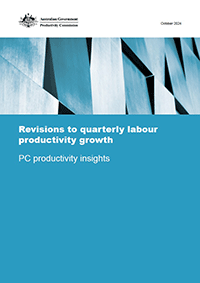Revisions to quarterly labour productivity growth
PC productivity insights
Released 24 / 10 / 2024
This paper considers revisions to quarterly productivity growth estimates and finds that measured labour productivity does not approach a ‘true’ estimate; rather, the figure is consistently changing. In light of this, it discusses two possible options to interpret labour productivity data:
- applying confidence intervals helps inform the reliability of the quarterly estimates
- relying on the longer term trend of productivity (such as productivity through the year) reduces the volatility and improves the reliability of the estimates.

Key points
- Estimates of quarterly labour productivity growth are frequently used by decision makers in both the private and public sector. Determining the size of typical revisions can provide a better understanding of how to use productivity estimates in making decisions. While we know ABS data is subject to revision, we expected labour productivity estimates to stabilise over time. Our analysis, however, shows that measured labour productivity does not approach a ‘true’ estimate; rather, the figure is consistently changing.
- The nature of the revisions means that the reliability of the original estimate is approximately the same for the estimate one year, or even three and four years after its original release.
- This paper discusses two possible options to assist in the interpretation of the labour productivity estimates:
- applying confidence intervals helps inform the reliability of the quarterly estimates
- relying on the longer term trend of productivity (such as productivity through the year) reduces the volatility and improves the reliability of the estimates.
- Approximately 70% of estimates fall within -0.4 to 0.5 percentage points of the original quarterly estimate three years after the original release. This range holds relatively stable from three years after the original release onwards.
- There are some patterns that emerge in the revisions:
- on average, June figures are revised downward while September figures are revised upward
- there is a tendency for larger estimates, both positive and negative, to have a larger revision
- positive estimates are more likely to be revised downward, and negative estimates are more likely to be revised upward. In other words, the original estimate tends to be more extreme, before being revised towards zero
- revisions are largest in the September quarter, when the ABS benchmarks their estimates.
Contents
- Preliminaries: Cover, Copyright and publication detail and Contents
- Key points
- Introduction
- Observations of labour productivity estimates
- Interpreting these revisions
- Patterns among the revisions
- Appendix
- Abbreviations
- References
We value your comments about this publication and encourage you to provide feedback.